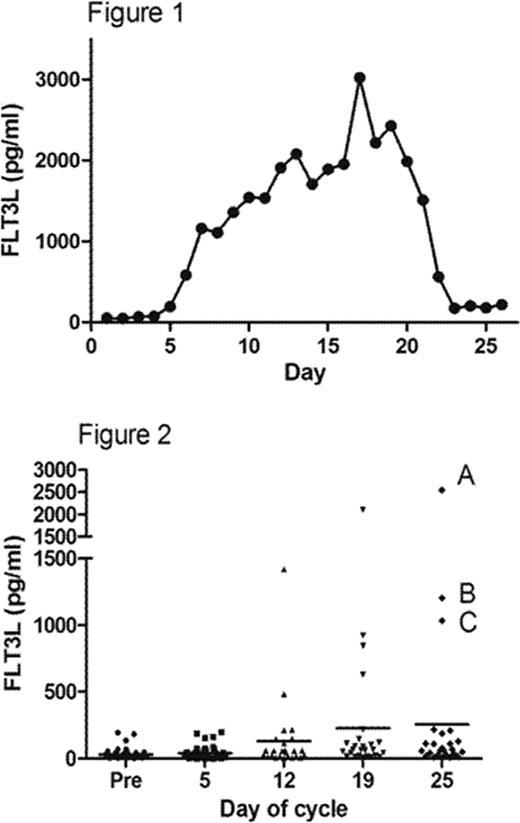Abstract
Abstract 2599
FLT3-ITD is a major risk factor for relapse and poor clinical outcome in AML. Markedly elevated levels of FLT3 ligand (FLT3L) occur after intensive chemotherapy and in patients with relapsed AML. In addition, elevated circulating FLT3L in relapsed/refractory FLT3-ITD+ AML has been proposed to limit the response to FLT3 inhibitors (Sato T, et al. Blood 2011; 3286). Novel agents including hypomethylating agents and mTOR inhibitors are being investigated as salvage options in AML but their impact on circulating FLT3 ligand is unknown.
To investigate the effect of azacitidine in combination with mTOR inhibitors on FLT3 ligand levels in relation to clinical outcome in relapsed and refractory AML.
A phase Ib/II open label dose escalation study using azacitidine 75 mg/m2 sc daily on days 1–5 and 8–9 of each 28-day cycle with 2.5, 5 or 10 mg everolimus orally on days 5–21. Serum was sampled at baseline and on days 5, 12 19 and 25 of cycle 1 and FLT3 ligand measured quantitated by ELISA.
37 patients, median age 65 years (range 17–78), with relapsed (73%) or refractory (27%) AML, after failing 1 (n=16), 2 (n=13) or 3 (n=8) previous lines of chemotherapy received azacitidine in combination with 2.5mg (n=6), 5mg (n=12) or 10mg (n=19) everolimus. Poor risk karyotype was present in 10/34 (29%) and FLT3-ITD in 4/16 (25%) of those evaluable. Clinical response was 32% (2 CR, 10 PR). At a median follow up of 252 days, median OS is 211 days (194d in primary refractory and 211d in relapsed AML) and median PFS 178 days. 3/5 patients treated for relapsed AML after allo-SCT had clinical responses and remain alive at 245, 252 and 525 days. In comparison to the typically large increase in FLT3L in a patient given intensive HiDAC-based induction chemotherapy (Figure 1), only 4/26 patients given azacitidine + everolimus had FLT3L levels above 1000 pg/ml within the first month of therapy (Figure 2). Furthermore, patients A, B and C (Figure 2) achieved CR, PR or had SD on therapy, suggesting that elevated FLT3L was unlikely to affect the clinical response to this treatment regimen. Finally, of 4 patients with FLT3-ITD+ AML failing prior intensive chemotherapy, absolute changes in the number of bone marrow blasts in those given azacitidine + everolimus were −80%, −85%, +5% and +7%.
Azacitidine in combination with the mTOR inhibitor everolimus has notable activity in chemoresistant AML, including those with FLT3-ITD and does not trigger clinically significant changes in circulating FLT3L that may impact on the efficacy of other therapeutic options.
Wei:Novartis: Honoraria, Research Funding; Celgene: Honoraria, Research Funding. Schwarer:Novartis: Honoraria, Membership on an entity's Board of Directors or advisory committees; Bristol-Myers Squibb: Honoraria, Membership on an entity's Board of Directors or advisory committees; Janssen-Cilag: Honoraria; Hospira: Membership on an entity's Board of Directors or advisory committees. Patil:Celgene: Research Funding.
Author notes
Asterisk with author names denotes non-ASH members.


This feature is available to Subscribers Only
Sign In or Create an Account Close Modal